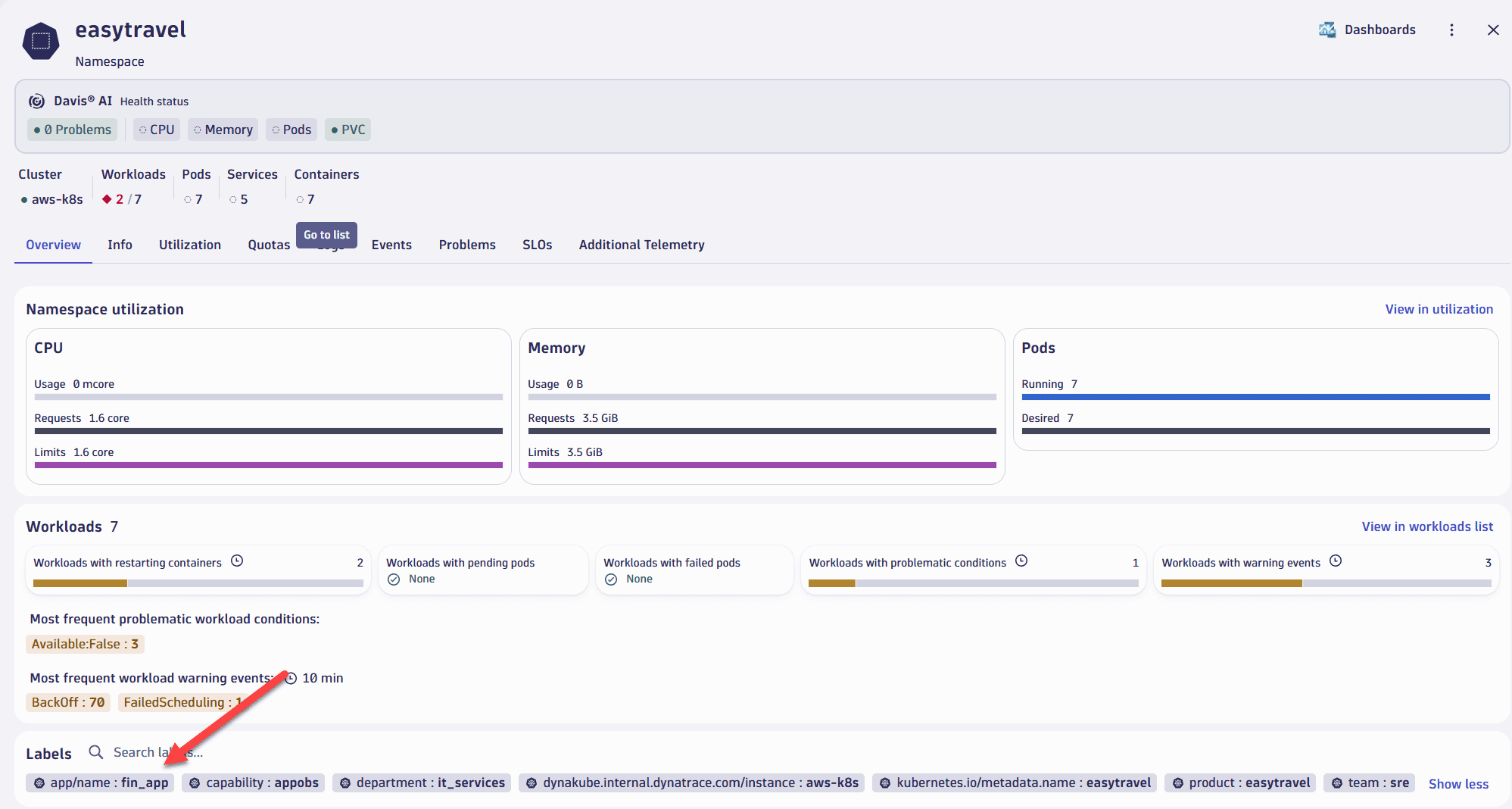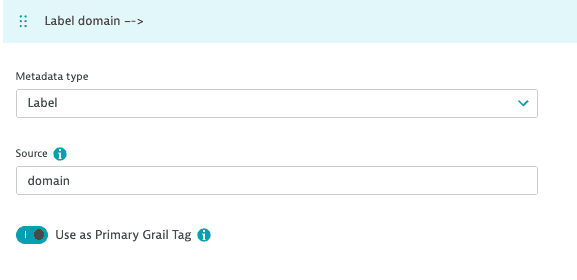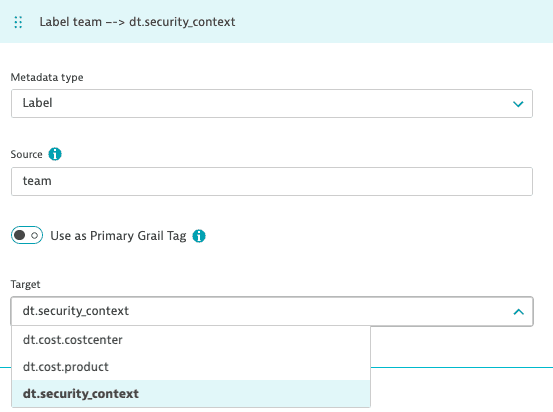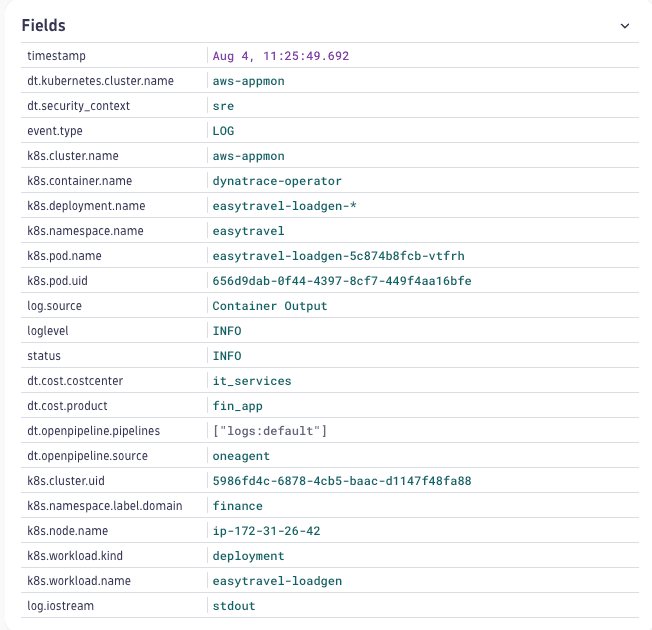Metadata enrichment of all telemetry originating from Kubernetes
- Latest Dynatrace
- 7-min read
Prerequisites
Operator version 1.6.0+, ActiveGate version 1.321+, OneAgent version 1.321+
- Dynatrace Operator is installed and running in your Kubernetes cluster.
- A valid DynaKube is applied to your cluster.
- Metadata enrichment is enabled.
Use cases
- Enhance your metrics, logs, trace data, events and entities with additional information using Kubernetes annotations and labels.
- Enhance your metrics, logs, trace data, events and entities with additional information using OpenTelemetry environment variables
- Enriched data can be used for defining access control to users, or for solving Cost Allocation in DPS.
- Enriched data can be used for pipeline routing, bucket segmentation, segmentation, and filtering.
Security context and Cost Allocation
In Dynatrace, you can set up policy boundaries for fine-grained restrictions on the data level. By default, you can use k8s.namespace.name and k8s.cluster.name, but sometimes this is not enough and you need a more fine grained way to set up your boundaries.
You might already have defined such boundaries for yourself and defined them as Kubernetes labels or annotations. This feature enables you to use these at the source for your security context in Dynatrace. If you have not done so already, we recommend to either use cluster or namespace name or set up a dedicated annotation for your Kubernetes workloads that serves as your security context.
Similarly Dynatrace provides a solution for Cost Allocation in DPS. You might already have the necessary data like department and product available in your existing Kubernetes labels or annotations. Even if not you might find it very convenient to setup up Cost Allocation as a Kubernetes annotation or label, which is what Dynatrace recommends. This feature then enables you to use these labels and annotations as the means to solving Cost Allocation in DPS.
The following attributes are supported:
Primary Grail Tags
To streamline tasks like bucket selection, segmentation, filtering, and problem routing, Dynatrace allows you to enrich your telemetry data using existing Kubernetes labels or annotations. These tags are made available as domain-specific fields, such as k8s.namespace.label.your_key or k8s.namespace.annotation.your_key.
We are working on automatically copying the domain-specific keys to primary_tags.<key>, enhancing usability and simplifying the tagging process. Primary Grail tags have already been added to the Semantic Dictionary.
Which data will be enriched
Data
Primary Grail Tags
Security Context
Cost Allocation
OneAgent Metrics
JMX/PMI Metrics collected via OneAgent
Planned
Service Metrics
Kubernetes platform metrics
Planned
OTLP Metrics
Planned
Metrics collected by OpenTelemetry Collector
Planned
Logs collected by OpenTelemetry Collector
Logs collected by OneAgent Log Module
Logs collected by FluentBit
Planned
Process entities
Planned for the new Smartscape
Planned for the new Smartscape
n/a
Service entities
Planned for the new Smartscape
n/a
OneAgent Events
Kubernetes Events
Planned
Enrichment options
Depending on the specific use case, the following enrichment options are supported:
Use settings to use existing labels and annotations (recommended)
We recommend this option, as it is the only option that enriches all signals, including Kubernetes platform metrics, events, and entities—unlike environment variables or manual pod annotations. Use Kubernetes enrichment rules to leverage your existing namespace labels and annotations. The tenant configuration is applied to all Kubernetes clusters by default. However, you can override it for specific clusters if needed.
Hint: If you setup your rules before you deploy your Dynakube, you don't need to wait 45 minutes for the rules to be propagated.
-
Go to Kubernetes App > Namespace > Select your namespace to have an overview of your existing namespace labels.

-
Go to Settings > Cloud and virtualization > Kubernetes telemetry enrichment.
-
Select Add rule.
-
Select
AnnotationorLabelin the Metadata type dropdown. -
Enter the namespace annotation/label key in the Source field, following Kubernetes conventions:
-
For primary Grail tag enrichment, turn on Use as Primary Grail Tag.

-
For remapping, turn off Use as Primary Grail Tag and choose a value from the Target dropdown.

-
Select Save changes.
-
After creating or modifying rules, allow up to 45 minutes for the changes to take effect. Once this time has passed, restart your pods.
-
Navigate to your data and verify that the metadata is successfully enriched.

Use dedicated Dynatrace metadata pod annotations
This works automatically for OneAgent and OpenTelemetry code-change scenarios.
This option is intended for scenarios where namespace labels or annotations cannot be used as a source. If both methods are present, manual annotations take precedence.
Unlike the settings-based approach, manually added pod annotations do not provide full enrichment. They will not enrich Kubernetes metrics, Kubernetes events, or entities.
For Oneagent metrics and service metrics to be enriched with these attributes, they must follow the convention k8s.namespace.<label>/<annotation>.<key>: <value>.
For comprehensive enrichment, the settings-based approach is recommended.
You might create the following annotations at the pod level:
metadata:annotations:metadata.dynatrace.com/dt.security_context: sremetadata.dynatrace.com/dt.cost.costcenter: it_servicesmetadata.dynatrace.com/dt.cost.product: fin_appmetadata.dynatrace.com/k8s.namespace.label.domain: finance
The following attributes will enrich the data:
dt.security_context: sredt.cost.costcenter: it_servicesdt.cost.product: fin_appk8s.namespace.label.domain: finance
OpenTelemetry setup
For OTLP setups without OneAgent, additional steps for signal enrichment are required. This can be achieved either by modifying your code to parse metadata files provided by the operator or by using environment variables.
Enrich via code changes (recommended)
This option is suitable for standalone OTLP setups without OneAgent injection. For optimal results, enrich your OTLP telemetry by parsing Dynatrace metadata files and adding the metadata directly in your code, as outlined in Enrich ingested data with Dynatrace-specific dimensions. You can find code samples in our OpenTelemetry section, like here for Java. This approach provides enrichment comparable to the OneAgent case.
Enrich via environment variable
If modifying your code isn't feasible, you can use the OTEL_RESOURCE_ATTRIBUTES environment variable for enrichment. However, this method has limitations: configuration can be complex, and certain properties, like k8s.container.name and Primary Grail Tags, must be set as static strings.
1. Create a config map for cluster level attributes
- Store DynaKube name
DYNAKUBE="dynakube" # set this to the name of your DynaKube / kubectl get dynakube -n dynatrace
- Get
k8s.cluster.uid
K8S_CLUSTER_UID="$(kubectl get dynakube -o jsonpath='{.status.kubeSystemUUID}' -n dynatrace $DYNAKUBE)"
- Get
k8s.cluster.name
K8S_CLUSTER_NAME="$(kubectl get dynakube -o jsonpath='{.status.kubernetesClusterName}' -n dynatrace $DYNAKUBE)"
- Get Kubernetes entity
dt.entity.kubernetes_cluster
DT_ENTITY_KUBERNETES_CLUSTER="$(kubectl get dynakube -o jsonpath='{.status.kubernetesClusterMEID}' -n dynatrace $DYNAKUBE)"
- Create config map in the target namespace
kubectl create configmap dynatrace-metadata \--from-literal K8S_CLUSTER_UID=$K8S_CLUSTER_UID \--from-literal K8S_CLUSTER_NAME=$K8S_CLUSTER_NAME \--from-literal DT_ENTITY_KUBERNETES_CLUSTER=$DT_ENTITY_KUBERNETES_CLUSTER \--namespace <YOUR_NAMESPACE>
2. Set K8s attributes via downward API on Pod
Adapt your Kubernetes pod specification by adding the following environment variables. You can include these in your Kubernetes Deployment or Pod manifest.
Primary Grail tags and k8s.container.name cannot be set via downward API.
It needs to be provided as a static string.
envFrom:- configMapRef:name: dynatrace-metadataoptional: falseenv:- name: K8S_CONTAINER_NAMEvalue: "" # replace with actual container name- name: K8S_POD_NAMEvalueFrom:fieldRef:apiVersion: v1fieldPath: metadata.name- name: K8S_POD_UIDvalueFrom:fieldRef:apiVersion: v1fieldPath: metadata.uid- name: K8S_POD_NAMESPACEvalueFrom:fieldRef:apiVersion: v1fieldPath: metadata.namespace- name: K8S_WORKLOAD_KINDvalueFrom:fieldRef:apiVersion: v1fieldPath: metadata.annotations['metadata.dynatrace.com/k8s.workload.kind'] # only works when metadata enrichment is enabled- name: K8S_WORKLOAD_NAMEvalueFrom:fieldRef:apiVersion: v1fieldPath: metadata.annotations['metadata.dynatrace.com/k8s.workload.name'] # only works when metadata enrichment is enabled- name: K8S_NODE_NAMEvalueFrom:fieldRef:apiVersion: v1fieldPath: spec.nodeName- name: DT_SECURITY_CONTEXT # only works when automatic security context enrichment is configuredvalueFrom:fieldRef:apiVersion: v1fieldPath: metadata.annotations['metadata.dynatrace.com/dt.security_context']- name: DT_COST_PRODUCT # only works when automatic cost product enrichment is configuredvalueFrom:fieldRef:apiVersion: v1fieldPath: metadata.annotations['metadata.dynatrace.com/dt.cost.product']- name: DT_COST_COSTCENTER # only works when automatic cost center enrichment is configuredvalueFrom:fieldRef:apiVersion: v1fieldPath: metadata.annotations['metadata.dynatrace.com/dt.cost.costcenter']
3. Add attributes to `OTEL_RESOURCE_ATTRIBUTES`
This example shows all our recommended attributes. Remove attributes that are not in use.
- name: OTEL_RESOURCE_ATTRIBUTESvalue: k8s.cluster.name=$(K8S_CLUSTER_NAME),k8s.cluster.uid=$(K8S_CLUSTER_UID),k8s.node.name=$(K8S_NODE_NAME),k8s.workload.name=$(K8S_WORKLOAD_NAME),k8s.workload.kind=$(K8S_WORKLOAD_KIND),k8s.pod.name=$(K8S_POD_NAME),k8s.pod.uid=$(K8S_POD_UID),k8s.namespace.name=$(K8S_POD_NAMESPACE),k8s.container.name=$(K8S_CONTAINER_NAME),dt.entity.kubernetes_cluster=$(DT_ENTITY_KUBERNETES_CLUSTER),dt.security_context=$(DT_SECURITY_CONTEXT),dt.cost.costcenter=$(DT_COST_COSTCENTER),dt.cost.product=$(DT_COST_PRODUCT)
To learn how to enrich signals with release metadata using the OTEL_RESOURCE_ATTRIBUTES environment variable, refer to the version detection strategies for detailed guidance.
Limitations
- Limit of 20 rules per configuration scope.
- Primary Grail tags do not yet enrich Kubernetes metrics or events.
- After creating or modifying rules, allow up to 45 minutes for the changes to take effect. Once this time has passed, restart your pods.
- Manually set
metadata.dynatrace.compod annotations take precedence. - Manually added attributes (anything other than
dt.security_context,dt.cost.costcenter, ordt.cost.product) do not enrich any Kubernetes metrics or Kubernetes events. - The settings-based approach does not work in conjunction with manually applied dedicated pod annotations. Using both simultaneously may cause conflicts, leading to unexpected behavior.
Troubleshooting
Verify the rule definition
- Confirm that each rule points to the correct metadata type (
labelvs.annotation). - Ensure the source key in the rule exactly matches the key that exists on the namespace.
Check that the source metadata really exists
-
Open the namespace in the Dynatrace Kubernetes app and look for the expected labels/annotations.
-
Alternatively, run
kubectl get namespace <name> -o yaml
and inspect the metadata.labels and metadata.annotations sections.
Validate that metadata enrichment is turned on
- The feature works only if
metadataEnrichmentis enabled in your DynaKube configuration. - If you specify a
namespaceSelectorin the DynaKube, make sure it matches the namespace you are testing.
Confirm that enrichment reached the pods
-
Inspect any pod in the namespace:
kubectl get pod <pod-name> -o yaml -
Look for annotations that start with
metadata.dynatrace.com/…. Their presence means the metadata is enriched.
Examples
Rules
Rules in builtin:kubernetes.generic.metadata.enrichment
"rules":[{# rule #1"type": "Annotation","source": "metadata.example.com/team","target": "dt.security_context"},{# rule #2"type": "Label","source": "department","target": "dt.cost.costcenter"},{# rule #3"type": "Label","source": "app/name","target": "dt.cost.product"}{# rule #4"type": "Label","source": "domain","primaryGrailTag": "true"}]
Namespace
Your existing namespace labels and annotations:
metadata:annotations:metadata.example.com/team: srelabels:department: it_servicesapp/name: fin_appdomain: finance
Pod
The Operator will create pod annotations:
metadata:annotations:metadata.dynatrace.com:|{"dt.security_context": "sre","dt.cost.costcenter": "it_services","dt.cost.product": "fin_app","k8s.namespace.label.domain": "finance"}
Telemetry
The following attributes will be enriched on the data:
dt.security_context: sredt.cost.costcenter: it_servicesdt.cost.product: fin_appk8s.namespace.label.domain: finance